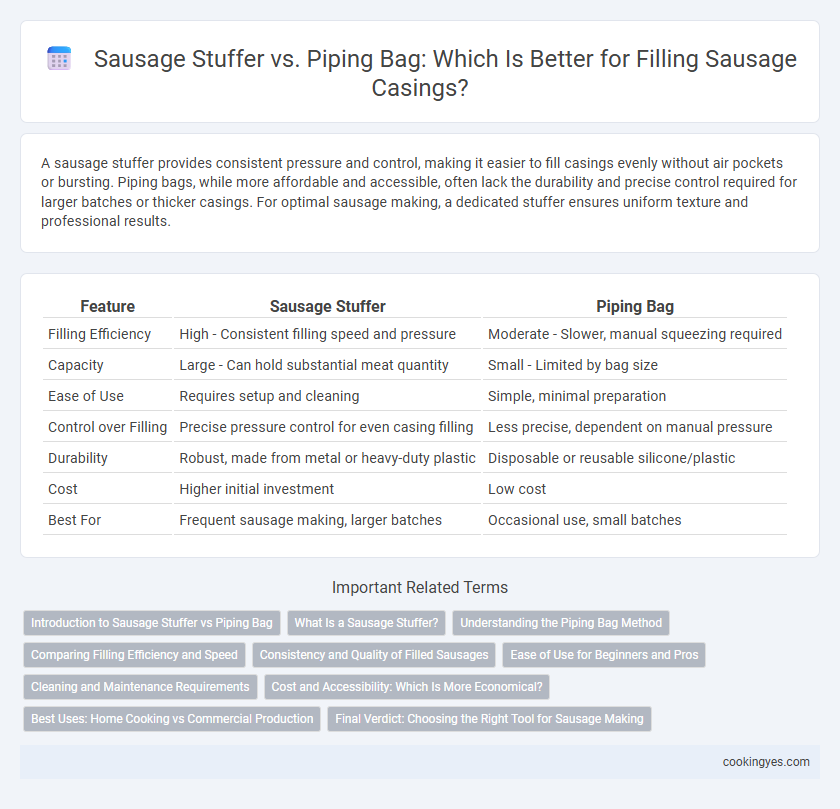A sausage stuffer provides consistent pressure and control, making it easier to fill casings evenly without air pockets or bursting. Piping bags, while more affordable and accessible, often lack the durability and precise control required for larger batches or thicker casings. For optimal sausage making, a dedicated stuffer ensures uniform texture and professional results.
Table of Comparison
| Feature | Sausage Stuffer | Piping Bag |
|---|---|---|
| Filling Efficiency | High - Consistent filling speed and pressure | Moderate - Slower, manual squeezing required |
| Capacity | Large - Can hold substantial meat quantity | Small - Limited by bag size |
| Ease of Use | Requires setup and cleaning | Simple, minimal preparation |
| Control over Filling | Precise pressure control for even casing filling | Less precise, dependent on manual pressure |
| Durability | Robust, made from metal or heavy-duty plastic | Disposable or reusable silicone/plastic |
| Cost | Higher initial investment | Low cost |
| Best For | Frequent sausage making, larger batches | Occasional use, small batches |
Introduction to Sausage Stuffer vs Piping Bag
A sausage stuffer offers precise control and consistent pressure when filling casings, making it ideal for uniform sausage production. In contrast, a piping bag provides a more flexible and affordable option but may require more skill to avoid air pockets and uneven filling. Choosing between a sausage stuffer and a piping bag depends on production scale, precision needs, and budget constraints.
What Is a Sausage Stuffer?
A sausage stuffer is a specialized kitchen tool designed specifically for filling sausage casings with ground meat efficiently and uniformly. It typically features a cylinder to hold the meat mixture and a nozzle through which the casing is placed and filled, ensuring precise control over the sausage size and texture. Compared to a piping bag, a sausage stuffer offers greater capacity and durability, making it ideal for large batches and professional sausage making.
Understanding the Piping Bag Method
The piping bag method for filling sausage casings offers precise control and reduces mess compared to traditional stuffer machines. This technique involves manually guiding the casing onto the tube while steadily squeezing the sausage mixture from the piping bag, ensuring even filling without air pockets. Ideal for small batches, piping bags provide an accessible and affordable alternative for artisanal sausage making.
Comparing Filling Efficiency and Speed
Sausage stuffers offer greater filling efficiency and speed compared to piping bags due to their mechanized pressure system, which consistently pushes meat into casings with minimal effort. Piping bags require manual squeezing, often resulting in slower filling and less uniform sausage density. For bulk sausage production, stuffers reduce preparation time and increase output, while piping bags suit smaller batches or intricate filling tasks.
Consistency and Quality of Filled Sausages
Using a sausage stuffer ensures uniform pressure and controlled filling, resulting in consistently dense and well-packed sausages that reduce air pockets and casing tears. In contrast, a piping bag often causes uneven filling and variable texture due to inconsistent pressure, leading to irregular sausage quality. The precision of a sausage stuffer enhances the overall quality and appearance of filled sausages, making it the preferred tool for producing professional-grade links.
Ease of Use for Beginners and Pros
Sausage stuffers offer greater ease of use for beginners by providing controlled, consistent filling with minimal mess, making them ideal for handling larger batches and thicker casings. Piping bags require more skill and finesse, often suited for pros who appreciate the tactile feedback and precision when working with smaller or delicate casings. Choosing between the two depends on the user's experience level, with sausage stuffers streamlining the filling process for novices and piping bags allowing expert control for advanced sausage makers.
Cleaning and Maintenance Requirements
Sausage stuffers feature detachable components that are easier to disassemble and clean thoroughly, minimizing bacterial buildup in crevices. Piping bags require less intensive maintenance but can be prone to retaining residual fat and meat paste if not rinsed immediately after use. Stainless steel stuffers typically offer more durable, dishwasher-safe parts compared to reusable silicone or cloth piping bags, which may require hand washing for preservation.
Cost and Accessibility: Which Is More Economical?
Sausage stuffers generally involve a higher initial cost, ranging from $50 to several hundred dollars depending on size and material, while piping bags are significantly more affordable, often under $20. Accessibility favors piping bags due to their availability in most kitchen stores and ease of replacement without specialized equipment. For occasional or small-scale sausage making, piping bags provide a more economical and convenient option, whereas sausage stuffers are a cost-effective investment for frequent or large-batch filling.
Best Uses: Home Cooking vs Commercial Production
Sausage stuffers provide consistent pressure and capacity ideal for commercial production, efficiently filling casings in large batches with minimal effort. Piping bags offer greater control and flexibility, making them best suited for home cooking or small-scale sausage making where precision and ease of use matter. Choosing between a sausage stuffer and piping bag depends on volume requirements and desired speed of filling casings.
Final Verdict: Choosing the Right Tool for Sausage Making
Sausage stuffers provide consistent pressure and control, ensuring uniform casing filling and reducing air pockets, which enhances sausage texture and appearance. Piping bags offer a more affordable, portable option but require greater manual skill and patience to avoid uneven stuffing and ruptured casings. For precision, efficiency, and professional results, a sausage stuffer is the optimal choice for serious sausage makers.
Sausage stuffer vs piping bag for filling casings Infographic

 cookingyes.com
cookingyes.com